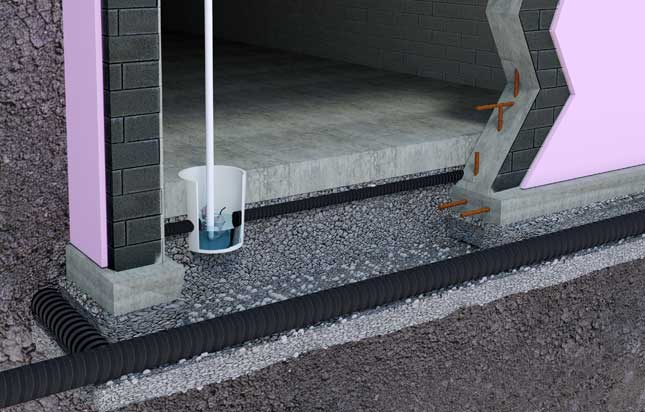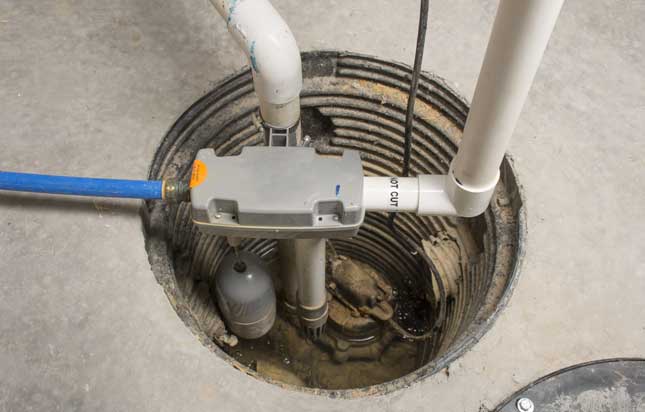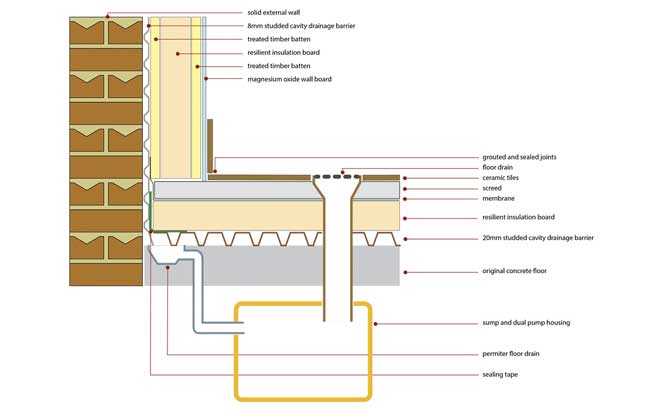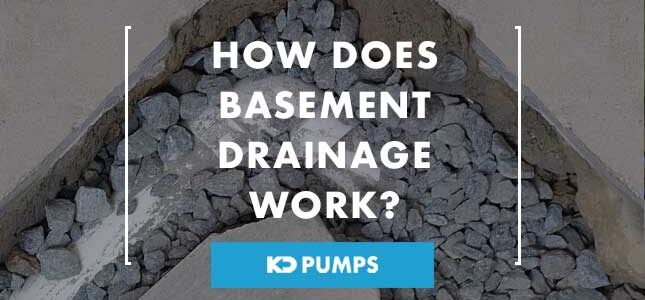How Does Basement Drainage Work?
If you’re new to construction and property maintenance, you might feel overwhelmed by the idea of basement drainage to keep your cellar dry all year round.
However, there’s no shame in not understanding how floor-based drainage systems can help protect your property against flooding.
This article aims to explain how basement drainage systems operate, and how they integrate into a broader waterproofing system designed to maintain a dry and usable basement.
Article Chapters
Choosing the Right Basement Drainage System

Image credit: Shutterstock
The most crucial aspect to understand about basement drainage is that it’s not a standalone solution.
Simply installing ground drainage facilities within the basement is insufficient to protect against flooding.
It’s necessary to have measures in place to direct excess water and other types of moisture towards the drainage system.
Without proper measures, the drainage system will remain unused, and water will accumulate.
The initial consideration when it comes to basement floor drainage is the below-ground waterproofing solution.
If your property has Type A, or “barrier protection,” waterproofing applied (either externally or internally), you may discover that a floor-based drainage system is not entirely compatible with your property.
To utilise a full floor drainage system, a Type C waterproofing solution, also known as a cavity drainage membrane system, is necessary.
Fortunately, this system can be used in combination with other types of waterproofing, making it a viable option for those who have Type A or Type B waterproofing systems installed, or for those with no below-ground waterproofing at all.
Unlike external construction work, these waterproofing solutions are applied solely to the interior of the property.
Sump Pump Systems

Basement Sump Pump System. Image credit: Shutterstock
For many projects, a mechanical pumping station is necessary to remove water that has penetrated the structure.
These stations, commonly used in below-ground applications, are often known as sump pumps or sump and pump systems.
Typically, a basement drainage system includes a perimeter drainage channel, a sump pit, a primary and secondary sump pump, a high-level water alarm and/or control panel, and a battery backup.
The sump chamber’s role is to collect rainwater and expel any excess water that has accumulated in the cavity drain membrane system to a suitable evacuation point.
It’s essential to engineer basement pump stations to handle the worst-case scenario of water ingress.
Cavity Drain Membrane
To understand how a cavity drain membrane system connects to your basement ground drainage system, it’s important to know how the system works.
The cavity drain membrane is a waterproof layer that is installed on the walls and flooring of your basement.
It’s secured in place with wall plugs that can be easily removed if necessary.
The membrane is designed to prevent water from entering your property by catching the water within the membrane.
Instead of attempting to block water from entering your basement, the membrane allows water to enter but directs it towards a drainage system that is installed alongside it.
This drainage system is typically a network of pipes and channels that direct the water towards a sump pump or other evacuation point.
This allows the water to be safely removed from your basement without causing damage or flooding.
After the water has been caught by the cavity drain membrane, it’s directed to a perimeter drainage channel, which is installed around the perimeter of the basement walls.
It’s designed to collect and carry the water away to a sump chamber or a pump system for safe disposal.
This allows the water to be safely removed from the property without causing damage or flooding.
Plan Ahead
It should be anticipated that groundwater will eventually rise against any structure during its lifespan.
Waterproofing designs should extend to the full height of the external ground level and consider the connection with the damp course located 150mm above ground level.
This connection can be made within the cavity or dressed externally with a flashing.
Drainage channels are best installed in rebates and laid level at the wall/floor junction around the structure’s perimeter to enable water to drain by hydraulic gradient and discharge passively into sump chambers.
For larger projects, cross-floor span channels should be incorporated into the design.
It’s crucial to include inspection and access ports in the perimeter drainage channel design to facilitate maintenance and future cleaning of the drainage system.
The number of sump pump systems needed for each project will depend on several factors, including the basement’s overall size, perimeter, and drainage method.
Type C membranes should be installed above drainage channels.
We suggest using two pumps for each sump system to lower the risk of mechanical failure of the duty pump.
If the primary pump fails, the secondary backup pump will take over and discharge water ingress.
This ensures the basement drainage system remains operational and significantly reduces the potential for flooding.
Basement drainage systems are further improved with high-level water alarms, control panels, and battery backups, providing an additional layer of protection.
A high-level water alarm will alert the property owner if the sump pump system ceases to function.
Battery backups will keep the sump pumps powered in the event of a power outage.
Basement Drainage Maintenance Schedules

Cavity Drainage System Diagram. Image credit: Flood Guidance
When designing the system, it’s crucial to consider its serviceability and maintainability, such as having accessible perimeter drainage and sump pump servicing.
Like any electrical equipment, basement sump pumps need regular servicing, and the entire sump drainage system requires routine maintenance to ensure optimal functioning.
Sump pumps must be maintained.
We recommend having a qualified sump pump engineer examine and service the equipment every year.
Sump pumps running more frequently due to higher water tables, water drainage, or weather conditions should be examined more frequently, and we recommend servicing these every 6 months.
Basement Drainage Water Cycle
The process outlined above covers the complete water cycle upon encountering a basement.
When water penetrates the basement walls, it’s gathered by the Type C waterproofing system and directed towards a sump pump located in the perimeter drainage channels.
The water is then collected, stored, and pumped away safely by the sump pump when enough water is accumulated to activate the pumping mechanism.
If you want to ensure that your basement stays dry and avoid the hassle of dealing with water damage, a Type C waterproofing system might be the perfect solution for you.
With our professional sump pump installation services, you won’t have to worry about water flooding your basement.
Instead, the only sign of water will be the sound of your sump pump working effectively behind the scenes.
Don’t hesitate to contact KD Drainage to learn more about how we can help protect your property from basement flooding.


Comments are closed.